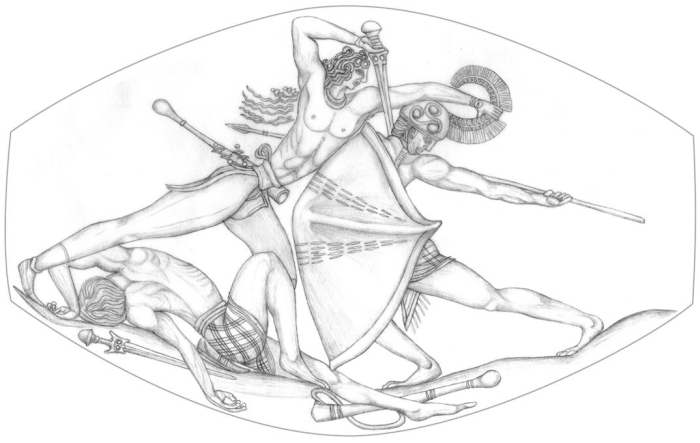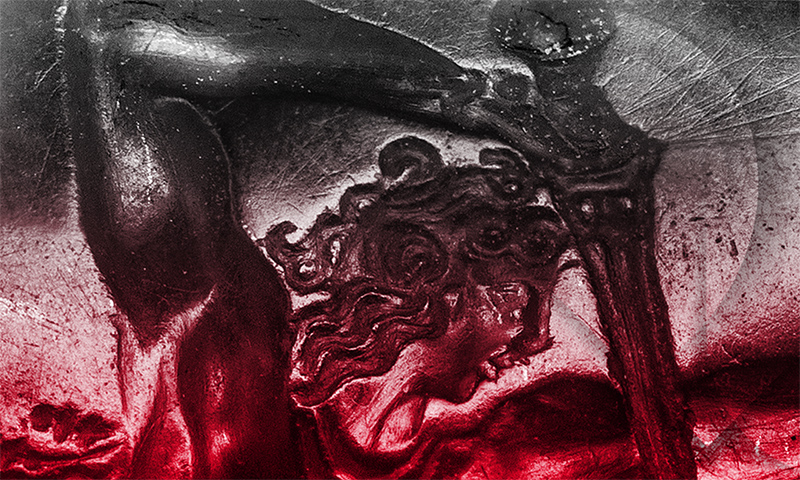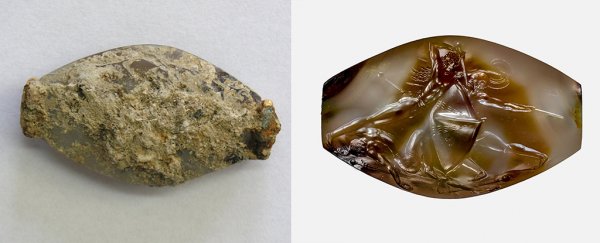It didn't look like much at first. A small piece of stone, just 3.6 centimetres (1.4 inches) in length, encrusted in a layer of limestone.
Found in a 3,500 year-old Bronze Age Warrior's Tomb in Pylos in Greece, it was set aside for more exciting treasure - but turned out to be the most stunning piece of the archaeological plunder.
After over a year of cleaning, researchers have uncovered an intricately carved gem: an agate sealstone, used for stamping an image onto clay or wax, that researchers have hailed as "one of the finest works of prehistoric Greek art ever discovered."
It could, they say, rewrite the history of ancient Greek art.
It shows a warrior, victoriously plunging his sword into a second foe, the first already defeated and crumpled on the ground at their feet. It's been named the Pylos Combat Agate.
 (The Department of Classics, University of Cincinnati)
(The Department of Classics, University of Cincinnati)
The tomb itself, uncovered in 2015, was a spectacular find. Inside was a remarkably intact Mycenaean skeleton, named the Griffin Warrior after an artefact buried with him, an ivory plaque carved with the image of a griffin.
The tomb was filled with treasure. At least 3,000 objects, including gold rings, silver cups, a sword with gold embroidery on the pommel, over 1,000 beads carved from precious stones, a suit of bronze armour, ivory combs, a gold necklace, and over 50 sealstones.
These items revealed a rich and deep culture. Many of the grave goods were Minoan in origin, indicating that the cultural exchange between the Minoans and the Mycenaeans was stronger and more extensive than previously thought.
They also helped uncover clues about the culture's religion, values, and burial rites. For instance, no clay artefacts were found in the graves, indicating that only metal and other precious materials such as ivory were appropriate for high status grave goods.
But the Pylos Combat Agate is a rare and transcendent thing, the researchers said.
 (T. Ross/The Department of Classics, University of Cincinnati)
(T. Ross/The Department of Classics, University of Cincinnati)
"What is fascinating is that the representation of the human body is at a level of detail and musculature that one doesn't find again until the classical period of Greek art 1,000 years later," said researcher Jack Davis of the University of Cincinnati.
"It seems that the Minoans were producing art of the sort that no one ever imagined they were capable of producing.
"It shows that their ability and interest in representational art, particularly movement and human anatomy, is beyond what it was imagined to be. Combined with the stylised features, that itself is just extraordinary."
 (The Department of Classics, University of Cincinnati)
(The Department of Classics, University of Cincinnati)
The skill and sophistication required to make such an intricate carving is unequalled by anything from the era - so detailed that photomicroscopy is needed to view them properly (see above).
Experts think it must have been engraved under a magnifying glass, even though so far archaeologists have not found any magnifying devices dating back to that time.
It's also a mystery as to what the stone depicts - although it was likely a popular legend of the time, researcher Shari Stocker of the University of Cincinnati said.
"It would have been a valuable and prized possession, which certainly is representative of the Griffin Warrior's role in Mycenaean society," she explained. "I think he would have certainly identified himself with the hero depicted on the seal."
It's still unknown who exactly the Griffin Warrior was, but if nothing else, he'll be remembered for the contribution his burial made to anthropology, archaeology, and art history. Work on the artefacts found in his tomb continues, and no doubt, the researchers said, there are more surprises ahead.
But it's going to be tough to beat the importance of this small piece of stone.
"This seal should be included in all forthcoming art history texts, and will change the way that prehistoric art is viewed," Stocker said.
A full analysis of the Pylos Combat Agate will be published in the journal Hesperia.
